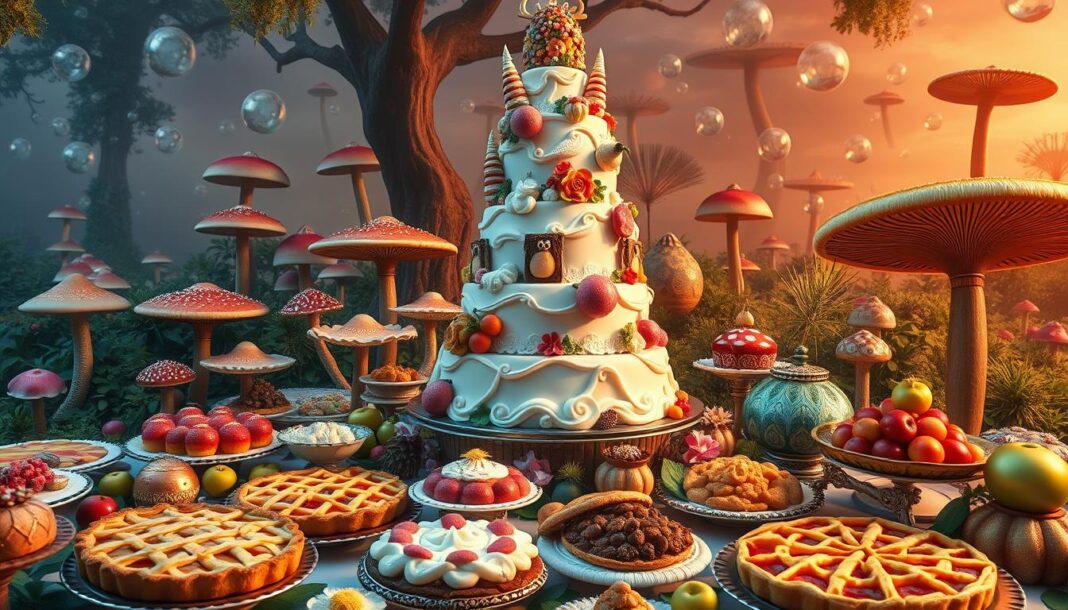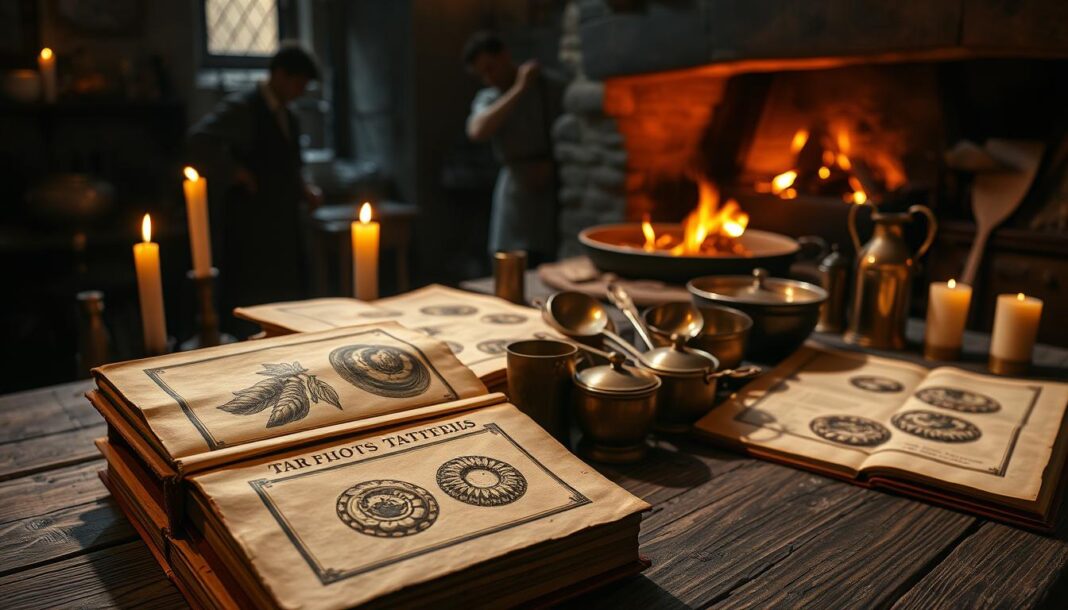Food has long been a staple in storytelling, playing a key role in film, television, and literature. We’ve often found ourselves captivated by fictional culinary creations that we’d love to taste just once. The nostalgia associated with these imaginary dishes sparked our imagination, and we began exploring the most memorable and mouth-watering fictional foods from our childhood.
As we delved into the world of fictional cuisine, we discovered that these creations often represent more than just sustenance in storytelling. They serve as powerful symbols and plot devices, leaving a lasting impact on our collective imagination. Our comprehensive guide examines the iconic foods from children’s literature, fantasy worlds, animated shows, and classic films, and how they’ve influenced real-world culinary creations.
Key Takeaways
- Fictional foods have become an integral part of our cultural heritage, symbolizing more than just sustenance in storytelling.
- Iconic fictional foods from literature and cinema continue to captivate audiences decades after their introduction.
- These imaginary dishes have inspired real-world culinary creations, showcasing their lasting impact on our culture.
- Our guide explores the historical context and significance of fictional foods in various forms of media.
- The nostalgia associated with fictional foods has contributed to their enduring popularity.
The Allure of Fictional Foods
The world of fiction is replete with culinary delights that not only tantalize our taste buds but also transport us to fantastical realms. Fictional foods have a way of captivating our imagination, often becoming an integral part of our cultural heritage.

We experience these foods vicariously through the characters and narratives, and they often leave an indelible impression on us. Most of these we first experienced in childhood, though some came slightly later in life. All of them left a lasting impact on at least one of us—and hopefully on some of our readers, too.
Why We Crave What Doesn’t Exist
The psychological underpinnings of our fascination with fictional foods reveal that they often seem more appealing than their real-world counterparts because they tap into universal desires and childhood fantasies about ideal food without nutritional consequences.
Food as Storytelling: Beyond Mere Sustenance
Food in fiction serves as more than background; it often becomes central to character development and plot advancement. Authors and filmmakers use detailed descriptions of fictional things we eat to create immersive, sensory-rich worlds that draw people in.
Willy Wonka’s Edible Wonderland
In the realm of fictional foods, Willy Wonka’s chocolate factory stands out as a masterpiece of culinary imagination. We explore Roald Dahl’s masterful creation as the ultimate food fantasy landscape that has captivated generations.
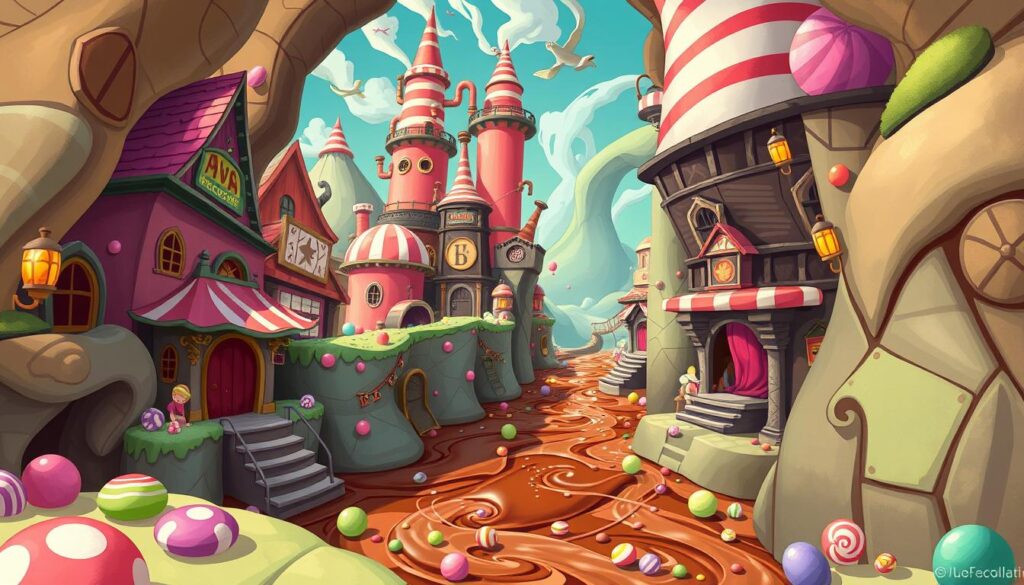
The Chocolate River: A Childhood Dream
The chocolate river is perhaps the most iconic fictional food setting, representing abundance and childhood dreams of unlimited sweets. As children, many of us fantasized about diving into such a river, and for some, that fantasy persists into adulthood.
Everlasting Gobstoppers and Mushroom Caps
Wonka’s Everlasting Gobstoppers exemplify impossible food physics, appealing to children’s desire for never-ending treats. The cream-filled mushroom caps, with their mix of textures and tastes, further exemplify the sensory appeal of Wonka’s creations.
We analyze these elements to understand how they contribute to the allure of Willy Wonka’s edible wonderland, a world where conventional food rules are delightfully broken.
Harry Potter’s Magical Feasts
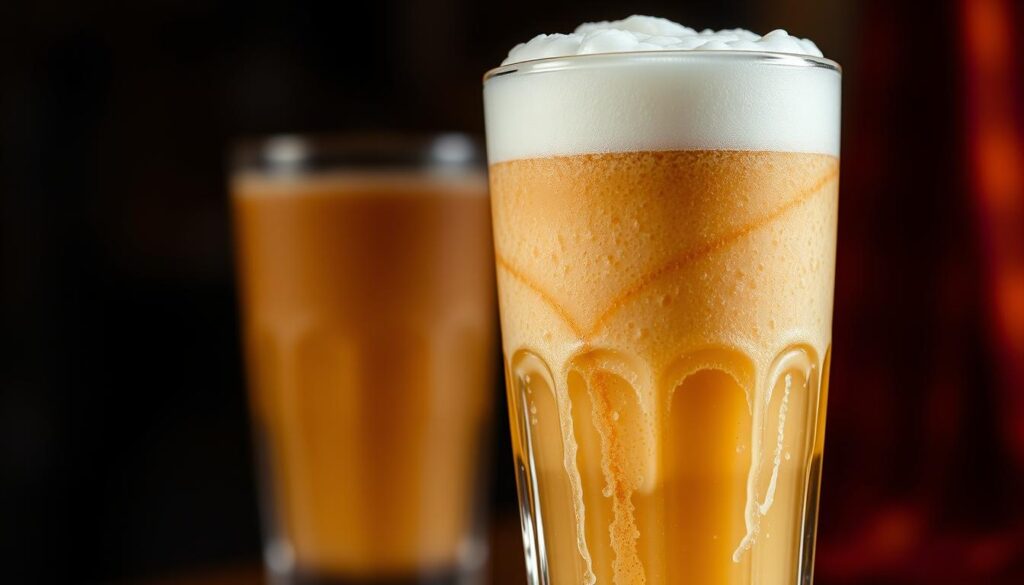
Food in the Harry Potter series is not just about satisfying hunger; it’s a powerful tool for world-building and storytelling. J.K. Rowling masterfully uses meals and feasts to create a rich, immersive experience, drawing readers into the wizarding world.
Hogwarts Welcome Feast: “It Was All Delicious”
The Hogwarts welcome feast is a prime example of how food represents abundance and belonging. For Harry, who’s been deprived of both, the feast is a revelation. The spread includes roast beef, roast chicken, and various other dishes that Harry enjoys without the fear of Dudley taking his food.
Butterbeer: The Wizarding World’s Favorite Drink
Butterbeer, with its sweet, butterscotch-like taste, is a cultural phenomenon that has transcended the series. It gets House-elves drunk and has become a real-world beverage at theme parks and in homemade recipes. The drink’s popularity underscores the impact of magical foods on our imagination and cultural practices.
The Best Fictional Foods Throughout Literary History
Literary history is replete with fictional foods that have captivated readers’ imaginations. These culinary creations not only tantalize our taste buds but also play a significant role in shaping the narrative and world-building in literature.
Redwall Abbey’s Legendary Feasts
Brian Jacques’ Redwall series is renowned for its elaborate feasts, which are a hallmark of the books. With three grand feasts per book, the series offers a culinary journey that delights readers. The feasts are described in lavish detail
Alice’s “Eat Me” Cake in Wonderland
Lewis Carroll’s “Eat Me” cake is one of literature’s most famous magical foods, symbolizing transformation and the surreal nature of Wonderland. This iconic treat has become an integral part of popular culture, representing the fantastical elements of the narrative. The cake’s significance extends beyond its taste, serving as a pivotal element in Alice’s adventures.
Bruce Bogtrotter’s Chocolate Cake from Matilda
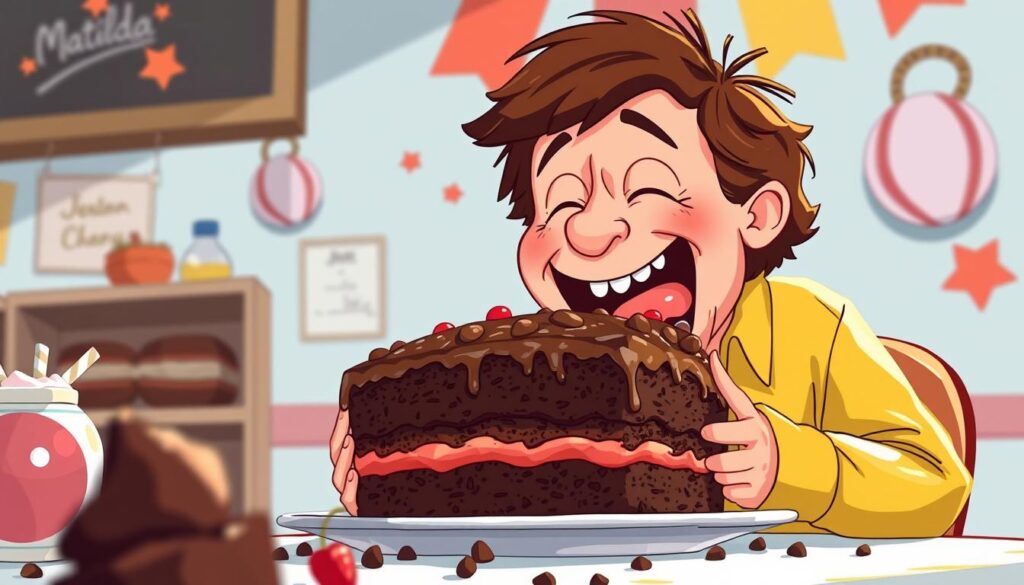
Roald Dahl’s depiction of Bruce Bogtrotter devouring a massive chocolate cake is an unforgettable moment in literature. This scene has become iconic, symbolizing the underdog’s victory over authority. We will analyze how this infamous chocolate cake represents both punishment and triumph, making it one of literature’s most memorable food moments.
The excessive chocolate cake becomes a symbol of rebellion against authority and the sweet taste of victory. In the movie adaptation, the visual presentation of the cake enhances its appeal, making it appear simultaneously intimidating and irresistible. This chocolate cake is not just a dessert; it’s a pivotal element in the narrative that resonates with people.
We will explore why this particular fictional food resonates with readers and viewers, combining the universal appeal of chocolate cake with the satisfaction of seeing an underdog triumph. The cake experience has become a cultural touchstone for discussions about food as punishment versus pleasure, making it a significant thing in popular culture.
The Phantom Tollbooth’s Edible Letters
In Norton Juster’s The Phantom Tollbooth, the concept of edible letters revolutionizes the way we perceive language. When Milo nibbles on a letter, he discovers it’s quite sweet and delicious, illustrating the novel’s central theme that knowledge can be savored.
This food for thought is not just a whimsical idea but a powerful metaphor for the joy of learning. The taste of the letters creates a synesthetic experience, assigning flavor to something typically visual, thus expanding readers’ imaginative capabilities.
At multiple times throughout the narrative, the edible letters remind readers that literacy is not just about consuming information but also about enjoying the process. This unique fictional food has influenced readers’ relationship with language, encouraging them to “taste” words in a new way.
The Three-Course Dinner Chewing Gum
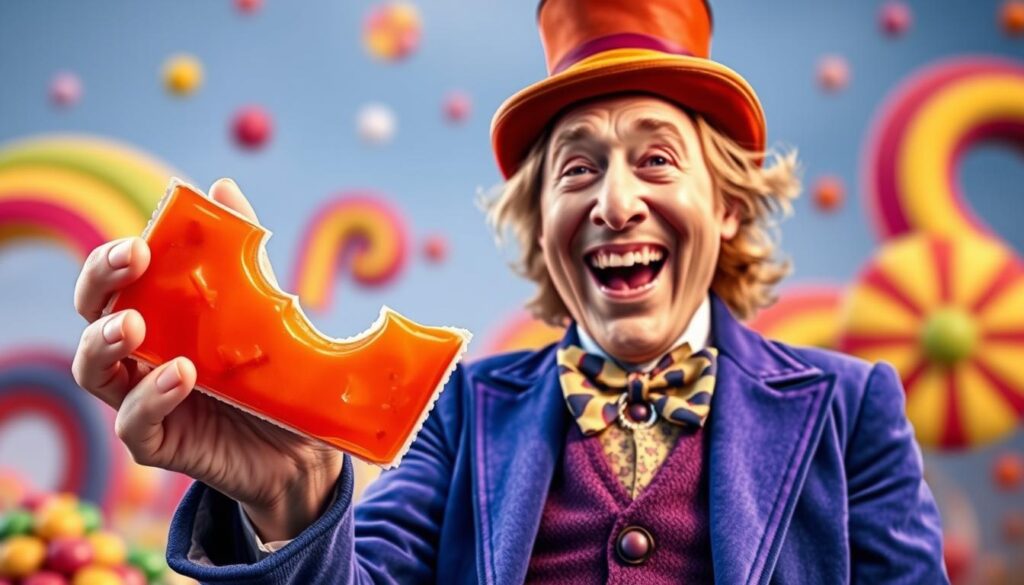
Roald Dahl’s depiction of Willy Wonka’s three-course dinner chewing gum is a testament to the power of imaginative storytelling. This fictional food item, featured in “Charlie and the Chocolate Factory,” has become an iconic representation of the Wonka Chocolate Factory’s innovative and fantastical approach to confectionery.
We analyze Roald Dahl’s three-course dinner chewing gum as a perfect example of food that appeals to children’s desire for convenience and immediate gratification. The gum’s ability to deliver multiple flavor experiences sequentially—tomato soup, roast beef, and blueberry—was revolutionary even in fiction, predating real-world food technology innovations.
The dramatic irony of Violet Beauregarde’s transformation into a blueberry serves as both a cautionary tale and an oddly appealing fantasy. This narrative element highlights the dangers of technological shortcuts in food production, a theme that remains relevant today. We explore how this fictional food concept has influenced real-world food science and the development of flavor-changing candies and gums.
Willy Wonka’s inventions, like the three-course dinner chewing gum, continue to inspire things in the culinary world, from innovative products to new culinary techniques. The allure of such fictional foods lies in their ability to spark imagination and inspire creativity.
Krabby Patties from SpongeBob SquarePants
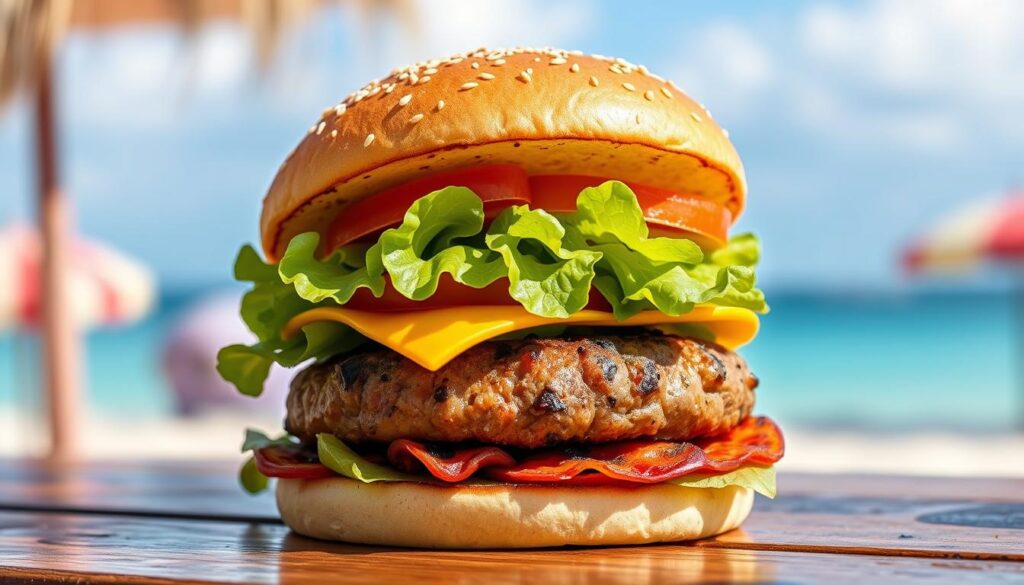
The allure of the Krabby Patty lies in its secret formula, a mystery that has intrigued fans of the SpongeBob SquarePants show. This iconic food from Bikini Bottom has become a cultural phenomenon, symbolizing the perfect fast food experience.
The mystique surrounding the Krabby Patty’s sauce has led to countless speculation and attempts to recreate it. SpongeBob’s dedication to preparing the perfect patty elevates fast food to an art form.
For fans, the Krusty Krab, the place where Krabby Patties are served, is a culinary destination. The Krabby Patty’s impact is evident in the numerous real-world recipe attempts and merchandise centered around this fictional food from the show.
More information about the foods and drinks in the SpongeBob universe can be found on the SpongeBob Fandom wiki.
The Flintstones’ Brontosaurus Ribs
The Flintstones’ depiction of brontosaurus ribs is a vivid representation of our day-to-day desires for oversized, indulgent food. This iconic scene from the closing credits showcases a drive-thru diner where the ribs are so massive they can tip a car over.
The brontosaurus ribs on The Flintstones represent the ultimate carnivorous fantasy, playing on the American barbecue tradition and exaggerating it to comical proportions. This comedic take on oversized meat is a hallmark of the show‘s humor.
The image of Fred’s car tipping from the weight of the ribs has become one of animation’s most memorable food moments, symbolizing the excess and fun associated with the prehistoric meal. It serves as a perfect example of the show‘s stone-age/modern-day mashup concept, blending the past with contemporary culture.
In our day-to-day life, such oversized meals continue to inspire real-world food challenges and restaurant marketing strategies, showing the lasting impact of The Flintstones’ culinary imagination.
Teenage Mutant Ninja Turtles’ Perfect Pizza
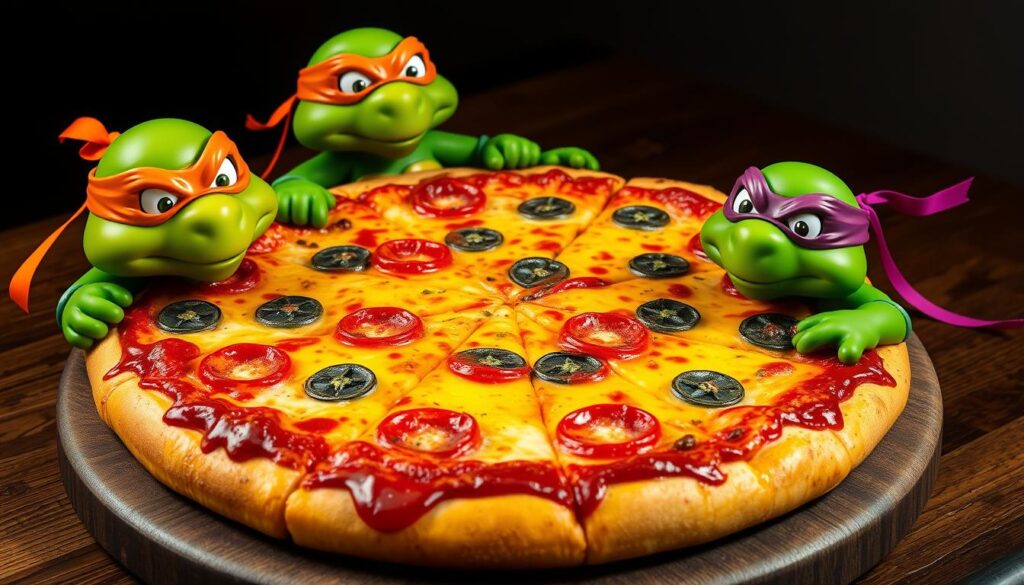
Pizza is more than just a meal in the Teenage Mutant Ninja Turtles universe. It’s a symbol of camaraderie and joy, often depicted as a central element in the Turtles’ gatherings. The perfect pizza, with its oozing cheese and vibrant toppings, became an iconic image that captivated audiences, especially children, in the 80s and 90s.
The TMNT franchise, both in the show and movie, portrayed pizza in an idealized manner, making it a staple of the Turtles’ diet. The animated pizza’s appearance, with its perfectly melted cheese and colorful toppings, set a high standard that real pizzerias struggled to match. Moreover, the Turtles’ unconventional topping combinations expanded children’s notions of what pizza could be.
The association between the Turtles and pizza was not just a matter of their love for food; it was also a marketing tool that created a lasting impression on the audience. This fictional representation of pizza influenced real-world pizza consumption, particularly among the generation that grew up watching the show.
Schwarzwälder Kirschtorte from Young Frankenstein
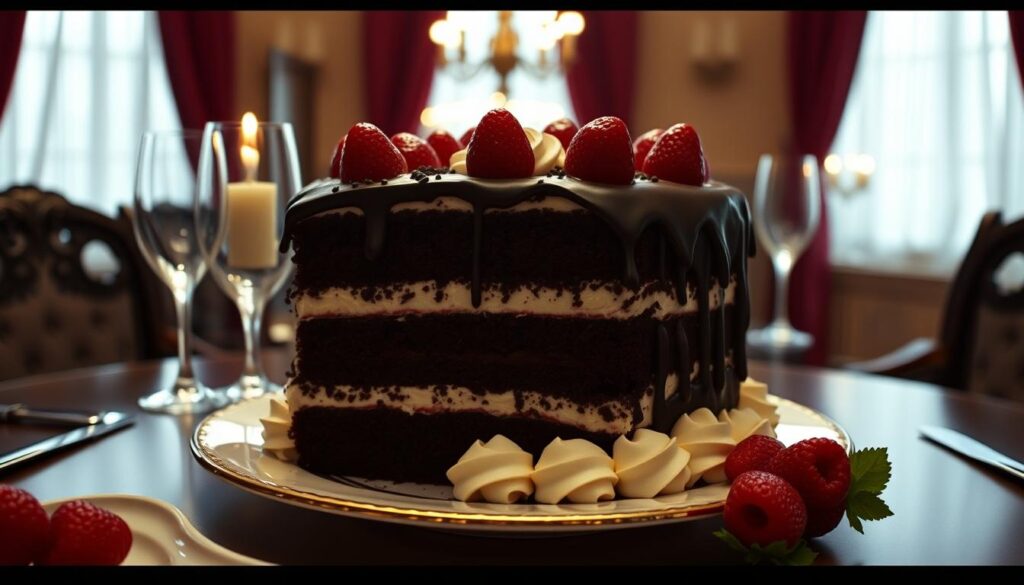
During a pivotal dinner scene in Young Frankenstein, the characters indulge in Schwarzwälder Kirschtorte, a rich German dessert. This movie moment showcases how food can be used to highlight character traits and create comedic tension.
We analyze how Mel Brooks’ Young Frankenstein uses Schwarzwälder Kirschtorte as both a comedy prop and cultural signifier. The elegant dessert contrasts with the film’s monster-making madness, establishing character dynamics among the people at the dinner table.
The “yummy sound” scene has become a cultural touchpoint for expressing food appreciation, demonstrating film’s influence on food culture at various times. This fictional food moment exemplifies how even brief culinary scenes in film can have lasting cultural impact.
The Floating Birthday Cake from A Time to Keep
A Time to Keep, written and illustrated by Tasha Tudor in 1977, is a treasure trove of nostalgic food scenes from rural New England. The book recounts a grandmother’s tales to a young girl about how seasons and holidays were celebrated in the old days. One of the most striking scenes is the floating birthday cake, a spectacle that combines celebration, nature, and sheer wonder.
We observe how this unusual cake presentation embodies the book’s theme of finding magic in simple pleasures and seasonal celebrations. The act of sending a candlelit cake floating down a river on a birthday is a unique way to make the celebration memorable. This moment showcases how fictional foods often incorporate elements of presentation and ritual, elevating them beyond everyday eating.
Tudor’s illustrations play a crucial role in enhancing the cake’s appeal, creating a dreamy, nostalgic vision of rural American food traditions. The combination of the familiar birthday cake with the unexpected twist of floating it down a river captures the imagination, making this a memorable place in the narrative.
All-of-a-Kind Family’s Lower East Side Treats
In All-of-a-Kind Family, Sydney Taylor masterfully weaves the story of an immigrant family’s life through their culinary experiences. The novel highlights the significance of street foods in creating a vivid portrait of early 20th-century New York.
| Food Item | Description |
|---|---|
| Sour Pickle | Eaten “greedily, with noise and gusto” |
| Sweet Potatoes | “Plump sweet potatoes in their gray jackets” |
| Candied Tangerine Slices | Sticks of candied tangerine slices and grapes |
These foods represent both childhood pleasure and economic realities, serving as cultural touchstones. Our list of fictional foods highlights their importance in preserving immigrant traditions.
Saturday Night Fever’s Iconic Pizza Fold

The 1977 film Saturday Night Fever introduced a pizza-eating technique that would become a cultural phenomenon. John Travolta’s character effortlessly folds and consumes two slices of pizza with one hand, a move that has been emulated but rarely mastered.
This iconic scene not only showcases the character’s casual confidence but also represents urban street-food culture and working-class masculinity in 1970s Brooklyn. The pizza fold has since been referenced and parodied in numerous films and TV shows, cementing its place in pop culture history.
To achieve this iconic fold, one needs two smallish slices of plain pizza, light on the cheese and sauce, much like those found at classic New York pizzerias. The original Patsy’s on First Avenue in East Harlem serves such minimalist coal-oven masterpieces, ideal for folding and eating with one hand, just like a true New York man.
The Chronicles of Narnia’s Turkish Delight
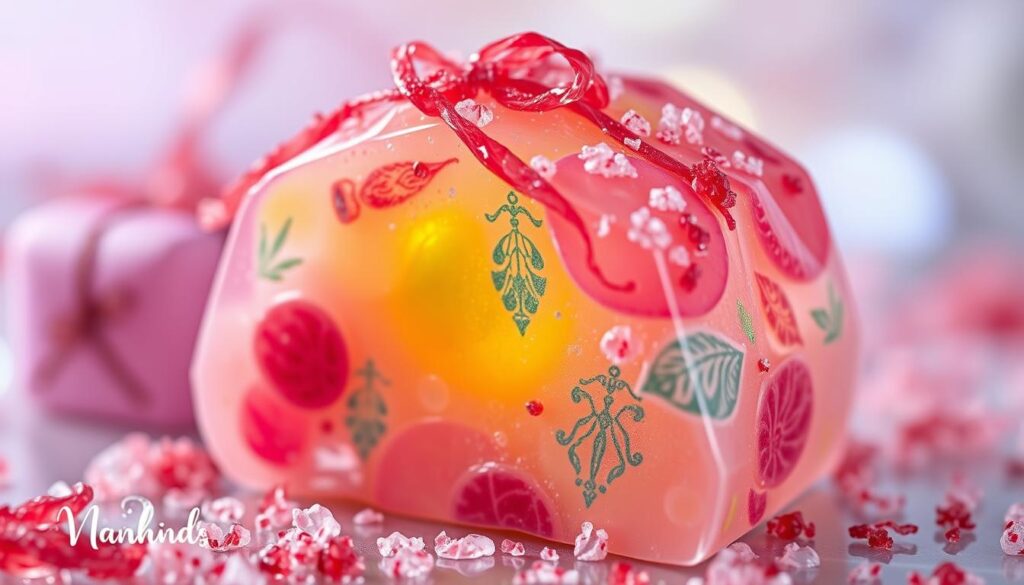
C.S. Lewis masterfully uses Turkish Delight in ‘The Lion, the Witch and the Wardrobe’ to symbolize temptation and betrayal. The White Witch’s offering of this confection to Edmund parallels biblical temptation narratives, elevating it to mythic status. In post-war Britain, where sugar rationing made such treats rare, Turkish Delight represented luxury and forbidden pleasure. Many readers’ first exposure to this candy came through the book, creating expectations that the real taste often couldn’t match. The movie adaptation visualized this pivotal moment, and sales of Turkish Delight increased at that times, sometimes paired with chocolate.
Why Fictional Foods Continue to Captivate Our Imaginations
There’s something undeniably captivating about the culinary creations that emerge from the realms of fiction. We examine why fictional foods continue to hold such powerful sway over our imaginations. These culinary fantasies tap into deeper human desires for abundance, transformation, and sensory pleasure. They often represent idealized versions of familiar dishes, like the perfect pizza or chocolate. As food memories from fiction intertwine with our childhood experiences, they create powerful nostalgic associations. This has inspired real-world chefs and designers to bring these beloved creations to life, bridging the gap between imagination and reality.
